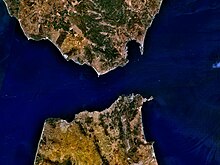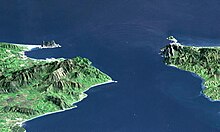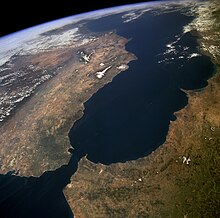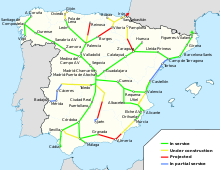Gibraltar tunnel

The planned Gibraltar tunnel is to cross under the Strait of Gibraltar in the form of a rail tunnel. This would connect the strait between Europe and Africa near Gibraltar .
Tunnel project
In December 2003, Spain and Morocco agreed at a summit meeting to resume the project first discussed in 1980. A budget of 27 million euros was made available for the preparation of feasibility studies for a two-tube railway tunnel with a maintenance tunnel .
In particular, a suitable route should be found in a three-year planning phase. The Spanish tunnel entrance should be 40 km west of Gibraltar, at Punta Palomas ; the Moroccan portal at Tangier (at Punta Malabata ). SNED and SECEGSA commissioned several seabed explorations.
On January 31, 2007, the European Commission adopted “Guidelines for Transport in Europe and the Neighboring Regions”. Among the five transnational axes as “ motorways of the sea ” was the “southwest axis”: “Connection of the south-western region of the EU with Switzerland and Morocco , with a connection to the Trans-Maghreb corridor through Morocco, Algeria and Tunisia and its extension to Egypt ”. According to a report by orf.at, Morocco has submitted its plans for a Gibraltar tunnel. The 2006 design competition for the tunnel was won by Giovanni Lombardi .
The Spanish and Moroccan governments have appointed a joint committee to study the feasibility of connecting the two continents. This resulted in the EUROMED transport project from 2003 to 2009.
In 2008 geological explorations raised doubts about the practicability. In March 2009, however, a contract was signed for a joint project between the Moroccan "Société Nationale d'Etudes du Détroit de Gibraltar" (SNED) and the Spanish "Sociedad Española de Estudios para la comunicacion fijaein Traves del Estrecho de Gibraltar SA" (SECEGSA ).
The idea of a tunnel for motor vehicles was rejected due to the currently very difficult engineering challenge with regard to ventilation with removal of the exhaust gases from the tunnel. The depth of the strait is about 900 meters on the shortest route, but only about 300 meters a little further west, where the European and African plates meet. The shortest connection is around 14 kilometers long. But the proposed route, which runs west of Tarifa to east of Tangier , is 23 kilometers long because it is not straight.
The tunnel is expected to be around 34 km long. An additional railway line would be needed to link the Spanish end of the tunnel near Tarifa with Algeciras , where the Talgo connection currently ends.
The project would be funded by two public service companies, SECEGSA in Spain and SNED in Morocco , with support from the European Union . It is not yet clear whether this will be a EUROMED project or a commercial consortium.
A report on the feasibility of the tunnel was presented by the European Union in 2009. So far there are no official figures on the cost of the project. But they are estimated to be at least five billion euros. The proposed railway tunnel would be around 39 km long and would cross the Mediterranean in a section that is only around 300 m deep. Construction would take around 15 years. In Morocco, the tunnel would be connected to the Tangier – Kenitra high-speed line , which opened in 2018.
An earlier plan was to connect the two continents via the narrowest part of the strait. But this idea was rejected because the tunnel would have been around 900 meters deep. The deepest underwater tunnel to date, the Eiksund tunnel , runs 287 m below sea level. As with the Eurotunnel , terminals for the loading of motor vehicles would also have to be built.
In 2013, Spanish, Moroccan and other European politicians reiterated the need to build the Gibraltar Tunnel, which was also expected to cost around 5 billion euros.
Connection to the rail traffic in Spain
At the end of 2010, the Spanish high-speed network ( AVE network) reached a total length of 2056 km, making it the longest high-speed rail network in Europe.
Connection to the rail transport in Morocco
In addition to the existing rail transport in Morocco , two TGV lines are being built for the high-speed network : from Tangier via Rabat , Casablanca and Marrakech to Agadir and from Rabat via Fès to Oujda .
The first route Tanger – Casablanca went into service in November 2018, with a speed of 320 km / h between Tangier and Kenitra . Alstom is supplying 14 TGV duplex trains to the Office National des Chemins de Fer (ONCF) .
Alternative bridge project
For several years, plans have been drawn up to build a bridge to connect Africa and Europe. This would be one of the longest bridges in the world. In addition to the length, the tectonic conditions and the protection of the pillars from ship collisions would place particular demands on the designers.
Several engineers have designed a bridge over the Strait of Gibraltar with different orientations and with different structural configurations.
TY Lin proposed a bridge between Punto Oliveros and Punto Cires , which, with a length of 14 kilometers, deep pillars, about 1000 m high towers and 5000 m span, would go far beyond the longest bridge built.
In 2004, architect Eugene Tsui published his concept of a floating bridge and submerged tunnels, with a three mile wide floating island in the middle of the Strait of Gibraltar.
Author Arthur C. Clarke described a bridge over the strait in his 1979 science fiction novel " Elevator to the Stars ".
In the east is Sabta / Ceuta (here left) and in the west is Tandja / Tanger .
Alternative dam project
A more unrealistic project is the construction of a dam across the Strait of Gibraltar. The plan goes back to the German architect Herman Sörgel , who planned and pursued this project, known as Atlantropa , throughout his life. The plan was to build a gigantic dam in the Strait of Gibraltar , which would have caused the sea level in the Mediterranean to drop by around 100 to 200 meters. The primary goal of this intergenerational project should be to gain new territory and energy for Europe and the African Mediterranean countries in abundance. A similar project for a partial dam was called in 1997 to mitigate climate change by diverting currents in the Atlantic.
Individual evidence
- ↑ a b c d Report Spain and Morocco are planning rail tunnels . In: Eisenbahn-Revue International , Issue 2/2004, ISSN 1421-2811 , p. 78.
- ↑ http://www.euromedtransport.org/Fr/accueil_4_46
- ↑ http://www.secegsa.gob.es/secegsa/lang_castellano/
- ↑ Political support for rail tunnel between Spain and Morocco - Global Rail News ( Memento from May 12, 2014 in the Internet Archive )
- ↑ Africa and Europe join together via the Strait of Gibraltar
- ↑ L'ONU préconise fortement la réalisation d'un tunnel sous le détroit de Gibraltar pour 5 billion €
- ↑ Spanish rail overtakes the rest of Europe . In: The Independent , December 19, 2010
- ↑ Morocco's first high-speed line inaugurated , Spiegel Online, November 16, 2018
- ↑ a b ONCF and Alstom sign a contract for the supply of 14 very high speed trains to Morocco. December 10, 2010, archived from the original on December 16, 2010 ; accessed on December 12, 2010 (English).
- ^ Climate Control Requires a Dam at the Strait of Gibraltar





